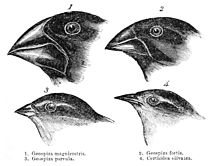Morphological integration
The Morphological Integration is a concept and research approach to biology that the degree of correlation , which between two or more characteristics of an organism , behind it takes is the approach underlying developmental or evolutionary causes in the context of evolutionary developmental biology to develop. It is a more holistic concept intended to complement the study of isolated mechanisms and characteristics. The concept of morphological integration is essentially based on the work of the zoologists Everett C. Olson and Robert Miller and the botanists Jens Clausen and William Hiesey in the 1950s.

Due to ontogenetic or evolutionary processes, individual structures in the organism change. This can either happen completely detached from other structures (= weak integration) or exclusively in unity with other, mostly surrounding structures (= strong integration). All degrees of integration are possible between these two extremes. In biological research, the degree of morphological integration can be determined using statistical methods that reveal and describe existing correlations between the structures to be examined, for example using geometric morphometry . Factors that promote the integration between two structures are always divided and unite those structures into a functional whole. Examples of such factors that affect the entire organism or larger organ complexes equally are pleiotropic genes, allometry , a common function or shared developmental pathways during embryonic development . However, due to exclusively local factors (e.g. very specific genes), structures can also separate themselves from other parts of the organism in their development. As a result, they are no longer necessarily phenotypically correlated with them, which leads to a modular structure, or in short to the modularity of the organism or individual organ complexes.
literature
- Klingenberg, CP (2008). Morphological integration and developmental modularity. Annual review of ecology, evolution, and systematics, 115-132.
- Philipp Mitteröcker & Bookstein, F. (2008). The evolutionary role of modularity and integration in the hominoid cranium. Evolution, 62 (4), 943-958.
- Massimo Pigliucci: Phenotypic Integration: Studying the Ecology and Evolution of Complex Phenotypes. Oxford University Press, 2004. ISBN 978-0-19-534775-3
- Everett C. Olson, Robert L. Miller: Morphological Integration. First published in 1958, expanded reprint in 1999. University of Chicago Press. ISBN 978-0-226-62905-6 (with afterword by Barry Chernoff & Paul M. Magwene: Morphological Integration fourty years later.)
Individual evidence
- ↑ Mark C. Kirschner, John C. Gerhart: The Solution to Darwin's Dilemma - How Evolution Creates Complex Life. Rowohlt, 2007, ISBN 3-499-62237-8 . (Orig .: The Plausibility of Life (2005)) p. 318ff